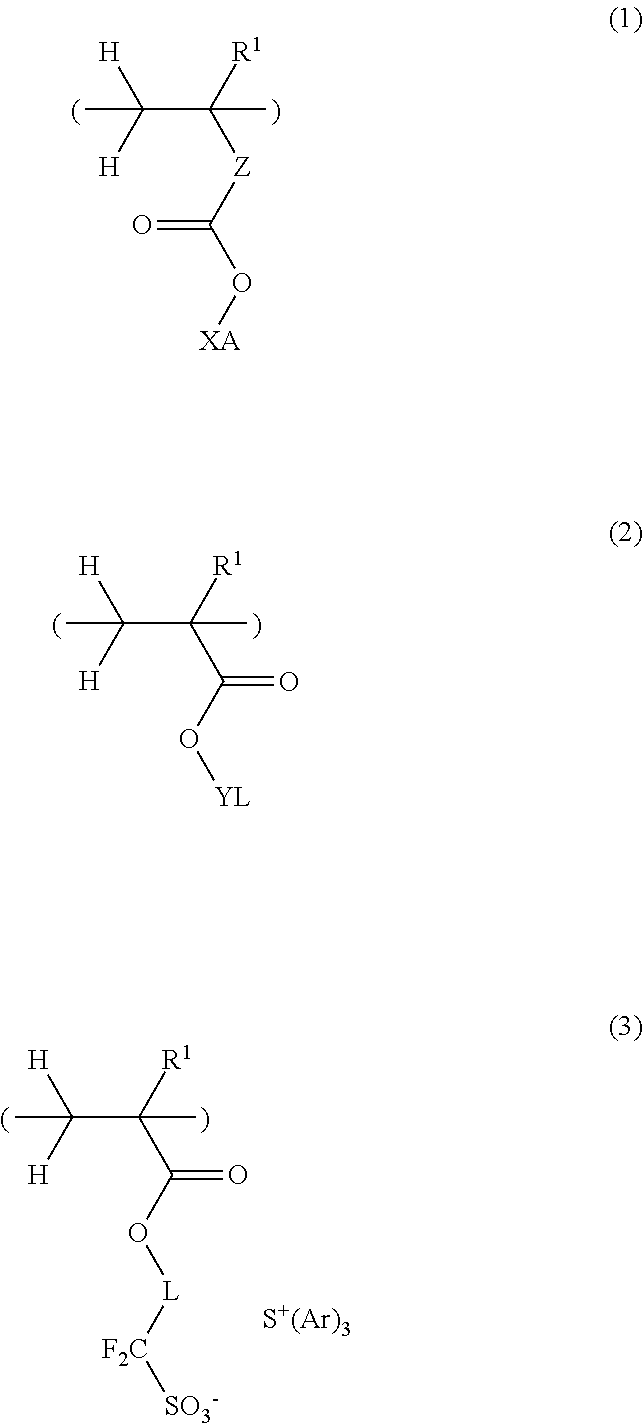Pattern forming process and resist compostion
a pattern forming and composting technology, applied in the field of pattern forming process and resist compostion, can solve the problems of poor quencher function, non-leachable resist material of technology, and several retarded development, and achieve the effect of low lwr and high resolution
- Summary
- Abstract
- Description
- Claims
- Application Information
AI Technical Summary
Benefits of technology
Problems solved by technology
Method used
Image
Examples
synthesis example 1
Synthesis of Triphenylsulfonium Nonafluorobutanesulfonamide (C-1)
[0138]3.4 g (0.01 mole) of potassium salt of nonafluorobutanesulfonamide, an amount (corresponding to 0.01 mole) of an aqueous solution of triphenylsulfonium methylsulfate and 25 g of dichloromethane were mixed, from which the organic layer was taken out. The organic layer was washed three times with 10 g of water, the solvent was distilled off in vacuum from the organic layer, and diisopropyl ether was added thereto, followed by decantation. The residue was concentrated in vacuum, obtaining 4.7 g of the target compound as oily matter. Yield 85%.
[0139]The compound thus obtained was analyzed by spectroscopy. FIGS. 1 and 2 are nuclear magnetic resonance spectra (1H-NMR and 19F-NMR in DMSO-d6) of the compound. It is noted that a trace of water was observed in 1H-NMR.
Infrared absorption spectroscopy (IR (D-ATR), cm−1):[0140]3062, 1477, 1448, 1350, 1271, 1233, 1191, 1130, 1066, 1033, 1014, 997, 976, 748, 729, 684, 591
Time-o...
examples 1-1 to 1-20
and Comparative Examples 1-1 to 1-11
[0147]A resist solution was prepared by selecting a quencher (in Synthesis Example), a polymer (in Synthesis Example), PAG, amine quencher, and alkali-soluble surfactant (F-1) in accordance with the formulation shown in Table 4, dissolving the components in a solvent, and filtering through a Teflon® filter having a pore size of 0.2 μm. The solvent contained 0.01 wt % of surfactant (F-2).
[0148]The PAG, solvent, amine quencher, alkali-soluble surfactant (F-1) and surfactant (F-2) in Table 4 are identified below.
TABLE 4ResinPAGQuencherSurfactantSolvent 1Solvent 2Resist(pbw)(pbw)(pbw)(pbw)(pbw)(pbw)Example1-1R-01P-1 (80)PAG-1 (6.6)C-1 (6.5)F-1 (5.0)PGMEA (1,728)GBL (192)1-2R-02P-1 (80)PAG-2 (7.6)C-1 (6.5)F-1 (5.0)PGMEA (1,728)GBL (192)1-3R-03P-1 (80)PAG-2 (7.6)C-2 (7.2)F-1 (5.0)PGMEA (1,728)GBL (192)1-4R-04P-1 (80)PAG-2 (7.6)C-3 (8.0)F-1 (5.0)PGMEA (1,728)GBL (192)1-5R-05P-1 (80)PAG-2 (7.6)C-4 (5.9)F-1 (5.0)PGMEA (1,728)GBL (192)1-6R-06P-1 (80)PAG-2 (...
PUM
| Property | Measurement | Unit |
|---|---|---|
| feature size | aaaaa | aaaaa |
| reaction time | aaaaa | aaaaa |
| reaction time | aaaaa | aaaaa |
Abstract
Description
Claims
Application Information
 Login to View More
Login to View More - R&D
- Intellectual Property
- Life Sciences
- Materials
- Tech Scout
- Unparalleled Data Quality
- Higher Quality Content
- 60% Fewer Hallucinations
Browse by: Latest US Patents, China's latest patents, Technical Efficacy Thesaurus, Application Domain, Technology Topic, Popular Technical Reports.
© 2025 PatSnap. All rights reserved.Legal|Privacy policy|Modern Slavery Act Transparency Statement|Sitemap|About US| Contact US: help@patsnap.com



